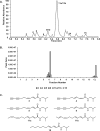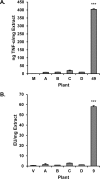Ethanolic Echinacea purpurea Extracts Contain a Mixture of Cytokine-Suppressive and Cytokine-Inducing Compounds, Including Some That Originate from Endophytic Bacteria
- PMID: 25933416
- PMCID: PMC4416932
- DOI: 10.1371/journal.pone.0124276
Ethanolic Echinacea purpurea Extracts Contain a Mixture of Cytokine-Suppressive and Cytokine-Inducing Compounds, Including Some That Originate from Endophytic Bacteria
Abstract
Echinacea preparations, which are used for the prevention and treatment of upper respiratory infections, account for 10% of the dietary supplement market in the U.S., with sales totaling more than $100 million annually. In an attempt to shed light on Echinacea's mechanism of action, we evaluated the effects of a 75% ethanolic root extract of Echinacea purpurea, prepared in accord with industry methods, on cytokine and chemokine production from RAW 264.7 macrophage-like cells. We found that the extract displayed dual activities; the extract could itself stimulate production of the cytokine TNF-α, and also suppress production of TNF-α in response to stimulation with exogenous LPS. Liquid:liquid partitioning followed by normal-phase flash chromatography resulted in separation of the stimulatory and inhibitory activities into different fractions, confirming the complex nature of this extract. We also studied the role of alkylamides in the suppressive activity of this E. purpurea extract. Our fractionation method concentrated the alkylamides into a single fraction, which suppressed production of TNF-α, CCL3, and CCL5; however fractions that did not contain detectable alkylamides also displayed similar suppressive effects. Alkylamides, therefore, likely contribute to the suppressive activity of the extract but are not solely responsible for that activity. From the fractions without detectable alkylamides, we purified xanthienopyran, a compound not previously known to be a constituent of the Echinacea genus. Xanthienopyran suppressed production of TNF-α suggesting that it may contribute to the suppressive activity of the crude ethanolic extract. Finally, we show that ethanolic extracts prepared from E. purpurea plants grown under sterile conditions and from sterilized seeds, do not contain LPS and do not stimulate macrophage production of TNF-α, supporting the hypothesis that the macrophage-stimulating activity in E. purpurea extracts can originate from endophytic bacteria. Together, our findings indicate that ethanolic E. purpurea extracts contain multiple constituents that differentially regulate cytokine production by macrophages.
Conflict of interest statement
Figures








References
-
- U.S. Nutrition Industry Overview. Nutrition Business Journal. 2009;14(6/7):1–13.
Publication types
MeSH terms
Substances
Grants and funding
LinkOut - more resources
Full Text Sources
Other Literature Sources

